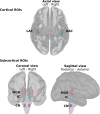Age-related hearing loss is associated with alterations in temporal envelope processing in different neural generators along the auditory pathway
- PMID: 35989932
- PMCID: PMC9389009
- DOI: 10.3389/fneur.2022.905017
Age-related hearing loss is associated with alterations in temporal envelope processing in different neural generators along the auditory pathway
Abstract
People with age-related hearing loss suffer from speech understanding difficulties, even after correcting for differences in hearing audibility. These problems are not only attributed to deficits in audibility but are also associated with changes in central temporal processing. The goal of this study is to obtain an understanding of potential alterations in temporal envelope processing for middle-aged and older persons with and without hearing impairment. The time series of activity of subcortical and cortical neural generators was reconstructed using a minimum-norm imaging technique. This novel technique allows for reconstructing a wide range of neural generators with minimal prior assumptions regarding the number and location of the generators. The results indicated that the response strength and phase coherence of middle-aged participants with hearing impairment (HI) were larger than for normal-hearing (NH) ones. In contrast, for the older participants, a significantly smaller response strength and phase coherence were observed in the participants with HI than the NH ones for most modulation frequencies. Hemispheric asymmetry in the response strength was also altered in middle-aged and older participants with hearing impairment and showed asymmetry toward the right hemisphere. Our brain source analyses show that age-related hearing loss is accompanied by changes in the temporal envelope processing, although the nature of these changes varies with age.
Keywords: EEG; age-related hearing loss (ARHL); auditory steady-state response (ASSR); auditory temporal processing; neural generators.
Copyright © 2022 Farahani, Wouters and van Wieringen.
Conflict of interest statement
The authors declare that the research was conducted in the absence of any commercial or financial relationships that could be construed as a potential conflict of interest.
Figures





Similar articles
-
Neural Generators Underlying Temporal Envelope Processing Show Altered Responses and Hemispheric Asymmetry Across Age.Front Aging Neurosci. 2020 Dec 4;12:596551. doi: 10.3389/fnagi.2020.596551. eCollection 2020. Front Aging Neurosci. 2020. PMID: 33343335 Free PMC article.
-
The association between hearing impairment and neural envelope encoding at different ages.Neurobiol Aging. 2019 Feb;74:202-212. doi: 10.1016/j.neurobiolaging.2018.10.008. Epub 2018 Oct 11. Neurobiol Aging. 2019. PMID: 30472387
-
Electrophysiological and Behavioral Evidence of Reduced Binaural Temporal Processing in the Aging and Hearing Impaired Human Auditory System.Trends Hear. 2018 Jan-Dec;22:2331216518785733. doi: 10.1177/2331216518785733. Trends Hear. 2018. PMID: 30022734 Free PMC article.
-
Effects of sensorineural hearing loss on temporal coding of narrowband and broadband signals in the auditory periphery.Hear Res. 2013 Sep;303:39-47. doi: 10.1016/j.heares.2013.01.014. Epub 2013 Jan 29. Hear Res. 2013. PMID: 23376018 Free PMC article. Review.
-
Effects of hearing loss and age on the binaural processing of temporal envelope and temporal fine structure information.Hear Res. 2021 Mar 15;402:107991. doi: 10.1016/j.heares.2020.107991. Epub 2020 May 11. Hear Res. 2021. PMID: 32418682 Review.
Cited by
-
Frequency-Following Responses in Sensorineural Hearing Loss: A Systematic Review.J Assoc Res Otolaryngol. 2024 Apr;25(2):131-147. doi: 10.1007/s10162-024-00932-7. Epub 2024 Feb 9. J Assoc Res Otolaryngol. 2024. PMID: 38334887 Free PMC article.
-
Cochlear Amyloid-β42 Accumulation Drives Progressive Auditory Neuropathy in 5XFAD Mice: A Potential Biomarker for Early Alzheimer's Disease.Res Sq [Preprint]. 2025 Apr 21:rs.3.rs-6431143. doi: 10.21203/rs.3.rs-6431143/v1. Res Sq. 2025. PMID: 40313736 Free PMC article. Preprint.
References
-
- Eisenberg LS, Dirks DD, Bell TS. Speech Recognition in Amplitude-Modulated Noise of Listeners With Normal Listeners With Impaired Hearing. (1995). Available online at: http://pubs.asha.org/ss/rights_and_permissions.aspx - PubMed
-
- Summers V, Molis MR. Summers Molis: Speech Recognition in Fluctuating Maskers 245 Speech Recognition in Fluctuating Continuous Maskers: Effects of Hearing Loss Presentation Level. (2004). Available online at: http://pubs.asha.org/ss/rights_and_permissions.aspx - PubMed
LinkOut - more resources
Full Text Sources

